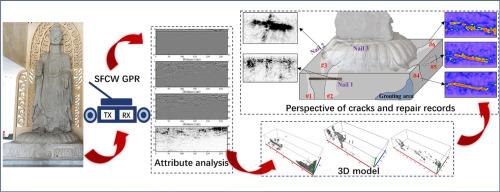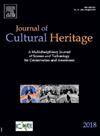破解石佛:三维探地雷达属性洞察苏美如王座裂缝与修复历史
IF 3.3
2区 综合性期刊
0 ARCHAEOLOGY
引用次数: 0
摘要
北魏石佛建于公元517年,现藏于中国青岛市崂山区青岛博物馆(36°6′5.58″N, 120°28′23.42″E)。几个世纪以来,自然风化过程和各种搬迁造成的破坏导致其苏美鲁王座内部出现裂缝,威胁到佛像的稳定性。在王座的表面可以看到以前的修复尝试。为了保证进一步修复措施的质量和有效性,必须彻底调查裂缝的发展情况和所有不可见的过去修复工作,这些工作可能会影响未来的修复。采用超宽带步进频率连续波探地雷达(SFCW)系统对佛苏美如王座进行了无创探测。我们使用了一种系统成像方法来解决探测王座内部微小特征的挑战。利用基于散射的速度估计、先进的GPR信号增强、Stolt偏移和包络属性提取,该方法揭示了高分辨率三维(3D)图像,为地下结构提供了前所未有的见解。获得的图像显示了内部裂缝,过去修复工作的细节,为指导未来的修复工作提供了有价值的见解。最后,我们讨论了探地雷达在调查石像方面的优势。本文章由计算机程序翻译,如有差异,请以英文原文为准。

Decoding the stone Buddha: Three-dimensional ground penetrating radar attribute insights into cracks and restoration history of Sumeru throne
The Northern Wei dynasty stone Buddha was built in 517 AD and is currently housed in Qingdao Museum, located in Laoshan District, Qingdao, China (36°6′5.58″N, 120°28′23.42″E). Over the centuries, the natural weathering process and the damage caused by various relocations has led to internal cracks on its Sumeru throne that threatens the stability of the Buddha. Previous restoration attempts are visible on the surface of the throne. To guarantee the quality and effectiveness of further restoration measures, it is essential to thoroughly investigate the cracks developments and all invisible past restoration efforts that might interfere future restoration. An ultra-wideband stepped-frequency continuous wave (SFCW) ground penetrating radar (GPR) system was employed to perform a non-invasive investigation of the Buddha Sumeru throne. We used a systematic imaging method to tackle the challenges of detecting tiny internal features within the throne. Leveraging scattering-based velocity estimation, advanced GPR signal enhancement, Stolt migration, and envelope attribute extraction, this approach unveils a high-resolution three-dimensional (3D) image, offering unprecedented insights into subsurface structures. The obtained images revealed the internal cracks, details of past restoration effort, offering valuable insights for guiding future restoration efforts. Finally, we discussed the advantages of GPR for investigating stone statues.
求助全文
通过发布文献求助,成功后即可免费获取论文全文。
去求助
来源期刊

Journal of Cultural Heritage
综合性期刊-材料科学:综合
CiteScore
6.80
自引率
9.70%
发文量
166
审稿时长
52 days
期刊介绍:
The Journal of Cultural Heritage publishes original papers which comprise previously unpublished data and present innovative methods concerning all aspects of science and technology of cultural heritage as well as interpretation and theoretical issues related to preservation.
 求助内容:
求助内容: 应助结果提醒方式:
应助结果提醒方式:


